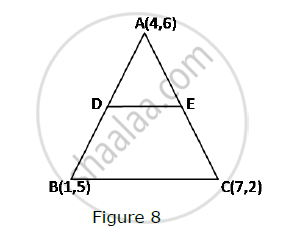Advertisements
Advertisements
Question
In Fig. 8, the vertices of ΔABC are A(4, 6), B(1, 5) and C(7, 2). A line-segment DE is drawn to intersect the sides AB and AC at D and E respectively such that `(AD)/(AB)=(AE)/(AC)=1/3 `Calculate th area of ADE and compare it with area of ΔABCe.

Solution
`(AD)/(AB)=(AE)/(AC)=1/3`
`:.(AB)/(AD)=(AC)/(AE)=3`
`:.(AD+DB)/(AD)=(AE+EC)/(AE)=3`
`:.1+(DB)/(AD)=1+(EC)/(AE)=3`
`:.(DB)/(AD)=(EC)/(AE)=2`
`:.(AD)/(DB)=(AE)/(EC)=1/2`
∴ AD:DB = AE :EC = 1: 2
So, D and E divide AB and AC respectively in the ratio 1:2.
So the coordinates of D and E are
`((1+8)/(1+2),(5+12)/(1+2))=(3,17/3) `

Area of ΔADE
`=1/2|(4xx17/3+3xx14/3+5xx6)-(3xx6+5xx17/3+4xx14/3)|`
`=1/2|(68/3+14+30)-(18+85/3+56/3)|`
`=1/2|((68+42+90)/3)-((54+85+56)/3)|`
`=1/2|(200/3)-(195/3)|`
`=1/2xx5/3`
`=5/6 `

Area of ΔABC
`=1/2|(4xx5+1xx2+7xx6)-(1xx6+7xx5+4xx2)|`
`=1/2|(20+2+42)-(6+35+8)|`
`=1/2|64-49|`
`=15/2`
`:.(`
APPEARS IN
RELATED QUESTIONS
Find the area of a triangle with vertices at the point given in the following:
(−2, −3), (3, 2), (−1, −8)
Find values of k if area of triangle is 4 square units and vertices are (−2, 0), (0, 4), (0, k)
Find the area of a triangle two sides of which are 18 cm and 10 cm and the perimeter is 42cm ?
If G(-2, 1) is the centroid of a ΔABC and two of its vertices are A(1, -6) and B(-5, 2) , find the third vertex of the triangle.
If the centroid of ΔABC having vertices A (a,b) , B (b,c) and C (c,a) is the origin, then find the value of (a+b+c).
Using integration, find the area of the triangle whose vertices are (2, 3), (3, 5) and (4, 4).
Using integration, find the area of triangle ABC, whose vertices are A(2, 5), B(4, 7) and C(6, 2).
Find the area of the triangle whose vertices are (-2, 6), (3, -6), and (1, 5).
The area of a triangle with vertices A, B, C is given by ______.
In the given figure, area of ΔPQR is 20 cm2 and area of ΔPQS is 44 cm2. Find the length RS, if PQ is perpendicular to QS and QR is 5 cm.

